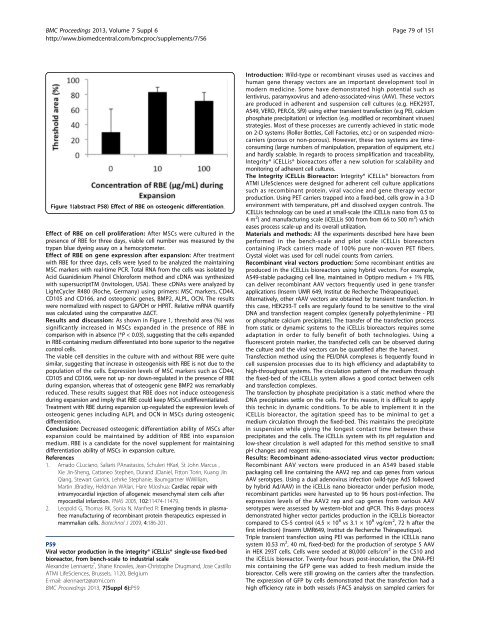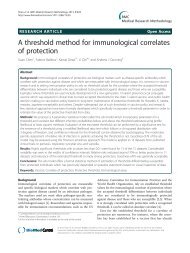Download PDF (all abstracts) - BioMed Central
Download PDF (all abstracts) - BioMed Central
Download PDF (all abstracts) - BioMed Central
You also want an ePaper? Increase the reach of your titles
YUMPU automatically turns print PDFs into web optimized ePapers that Google loves.
BMC Proceedings 2013, Volume 7 Suppl 6<br />
http://www.biomedcentral.com/bmcproc/supplements/7/S6<br />
Page 79 of 151<br />
Figure 1(abstract P58) Effect of RBE on osteogenic differentiation.<br />
Effect of RBE on cell proliferation: After MSCs were cultured in the<br />
presence of RBE for three days, viable cell number was measured by the<br />
trypan blue dyeing assay on a hemocytometer.<br />
Effect of RBE on gene expression after expansion: After treatment<br />
with RBE for three days, cells were lysed to be analyzed the maintaining<br />
MSC markers with real-time PCR. Total RNA from the cells was isolated by<br />
Acid Guanidinium Phenol Chloroform method and cDNA was synthesized<br />
with supersucriptTM (Invitologen, USA). These cDNAs were analyzed by<br />
LightCycler R480 (Roche, Germany) using primers: MSC markers, CD44,<br />
CD105 and CD166, and osteogenic genes, BMP2, ALPL, OCN. The results<br />
were normalized with respect to GAPDH or HPRT. Relative mRNA quantify<br />
was calculated using the comparative ΔΔCT.<br />
Results and discussion: AsshowninFigure1,thresholdarea(%)was<br />
significantly increased in MSCs expanded in the presence of RBE in<br />
comparison with in absence (*P < 0.03), suggesting that the cells expanded<br />
in RBE-containing medium differentiated into bone superior to the negative<br />
control cells.<br />
The viable cell densities in the culture with and without RBE were quite<br />
similar, suggesting that increase in osteogenisis with RBE is not due to the<br />
population of the cells. Expression levels of MSC markers such as CD44,<br />
CD105 and CD166, were not up- nor down-regulated in the presence of RBE<br />
during expansion, whereas that of osteogenic gene BMP2 was remarkably<br />
reduced. These results suggest that RBE does not induce osteogenesis<br />
during expansion and imply that RBE could keep MSCs undifferentiatiated.<br />
Treatment with RBE during expansion up-regulated the expression levels of<br />
osteogenic genes including ALPL and OCN in MSCs during osteogenic<br />
differentiation.<br />
Conclusion: Decreased osteogenic differentiation ability of MSCs after<br />
expansion could be maintained by addition of RBE into expansion<br />
medium. RBE is a candidate for the novel supplement for maintaining<br />
differentiation ability of MSCs in expansion culture.<br />
References<br />
1. Amado CLuciano, Saliaris PAnastasios, Schuleri HKarl, St John Marcus ,<br />
Xie Jin-Sheng, Cattaneo Stephen, Durand JDaniel, Fitton Torin, Kuang Jin<br />
Qiang, Stewart Garrick, Lehrke Stephanie, Baumgartner WWilliam,<br />
Martin JBradley, Heldman WAlan, Hare MJoshua: Cardiac repair with<br />
intramyocardial injection of <strong>all</strong>ogeneic mesenchymal stem cells after<br />
myocardial infarction. PNAS 2005, 102:11474-11479.<br />
2. Leopold G, Thomas RK, Sonia N, Manfred R: Emerging trends in plasmafree<br />
manufacturing of recombinant protein therapeutics expressed in<br />
mammalian cells. Biotechnol J 2009, 4:186-201.<br />
P59<br />
Viral vector production in the integrity® iCELLis® single-use fixed-bed<br />
bioreactor, from bench-scale to industrial scale<br />
Alexandre Lennaertz * , Shane Knowles, Jean-Christophe Drugmand, Jose Castillo<br />
ATMI LifeSciences, Brussels, 1120, Belgium<br />
E-mail: alennaertz@atmi.com<br />
BMC Proceedings 2013, 7(Suppl 6):P59<br />
Introduction: Wild-typeorrecombinantvirusesusedasvaccinesand<br />
human gene therapy vectors are an important development tool in<br />
modern medicine. Some have demonstrated high potential such as<br />
lentivirus, paramyxovirus and adeno-associated-virus (AAV). These vectors<br />
are produced in adherent and suspension cell cultures (e.g. HEK293T,<br />
A549, VERO, PER.C6, Sf9) using either transient transfection (e.g PEI, calcium<br />
phosphate precipitation) or infection (e.g. modified or recombinant viruses)<br />
strategies. Most of these processes are currently achieved in static mode<br />
on 2-D systems (Roller Bottles, Cell Factories, etc.) or on suspended microcarriers<br />
(porous or non-porous). However, these two systems are timeconsuming<br />
(large numbers of manipulation, preparation of equipment, etc.)<br />
and hardly scalable. In regards to process simplification and traceability,<br />
Integrity® iCELLis® bioreactors offer a new solution for scalability and<br />
monitoring of adherent cell cultures.<br />
The Integrity iCELLis Bioreactor: Integrity® iCELLis® bioreactors from<br />
ATMI LifeSciences were designed for adherent cell culture applications<br />
such as recombinant protein, viral vaccine and gene therapy vector<br />
production. Using PET carriers trapped into a fixed-bed, cells grow in a 3-D<br />
environment with temperature, pH and dissolved oxygen controls. The<br />
iCELLis technology can be used at sm<strong>all</strong>-scale (the iCELLis nano from 0.5 to<br />
4m 2 ) and manufacturing scale (iCELLis 500 from from 66 to 500 m 2 ) which<br />
eases process scale-up and its over<strong>all</strong> utilization.<br />
Materials and methods: All the experiments described here have been<br />
performed in the bench-scale and pilot scale iCELLis bioreactors<br />
containing iPack carriers made of 100% pure non-woven PET fibers.<br />
Crystal violet was used for cell nuclei counts from carriers.<br />
Recombinant viral vectors production: Some recombinant entities are<br />
produced in the iCELLis bioreactors using hybrid vectors. For example,<br />
A549-stable packaging cell line, maintained in Optipro medium + 1% FBS,<br />
can deliver recombinant AAV vectors frequently used in gene transfer<br />
applications (Inserm UMR 649, Institut de Recherche Thérapeutique).<br />
Alternatively, other rAAV vectors are obtained by transient transfection. In<br />
this case, HEK293-T cells are regularly found to be sensitive to the viral<br />
DNA and transfection reagent complex (gener<strong>all</strong>y polyethylenimine - PEI<br />
or phosphate calcium precipitate). The transfer of the transfection process<br />
from static or dynamic systems to the iCELLis bioreactors requires some<br />
adaptation in order to fully benefit of both technologies. Using a<br />
fluorescent protein marker, the transfected cells can be observed during<br />
the culture and the viral vectors can be quantified after the harvest.<br />
Transfection method using the PEI/DNA complexes is frequently found in<br />
cell suspension processes due to its high efficiency and adaptability to<br />
high-throughput systems. The circulation pattern of the medium through<br />
the fixed-bed of the iCELLis system <strong>all</strong>ows a good contact between cells<br />
and transfection complexes.<br />
The transfection by phosphate precipitation is a static method where the<br />
DNA precipitates settle on the cells. For this reason, it is difficult to apply<br />
this technic in dynamic conditions. To be able to implement it in the<br />
iCELLis bioreactor, the agitation speed has to be minimal to get a<br />
medium circulation through the fixed-bed. This maintains the precipitate<br />
in suspension while giving the longest contact time between these<br />
precipitates and the cells. The iCELLis system with its pH regulation and<br />
low-shear circulation is well adapted for this method sensitive to sm<strong>all</strong><br />
pH changes and reagent mix.<br />
Results: Recombinant adeno-associated virus vector production:<br />
Recombinant AAV vectors were produced in an A549 based stable<br />
packaging cell line containing the AAV2 rep and cap genes from various<br />
AAV serotypes. Using a dual adenovirus infection (wild-type Ad5 followed<br />
by hybrid Ad/AAV) in the iCELLis nano bioreactor under perfusion mode,<br />
recombinant particles were harvested up to 96 hours post-infection. The<br />
expression levels of the AAV2 rep and cap genes from various AAV<br />
serotypes were assessed by western-blot and qPCR. This 8-days process<br />
demonstrated higher vector particles production in the iCELLis bioreactor<br />
compared to CS-5 control (4.5 × 10 8 vs 3.1 × 10 8 vg/cm 2 ,72hafterthe<br />
first infection) (Inserm UMR649, Institut de Recherche Thérapeutique).<br />
Triple transient transfection using PEI was performed in the iCELLis nano<br />
system (0.53 m 2 , 40 mL fixed-bed) for the production of serotype 5 AAV<br />
in HEK 293T cells. Cells were seeded at 80,000 cells/cm 2 in the CS10 and<br />
the iCELLis bioreactor. Twenty-four hours post-inoculation, the DNA-PEI<br />
mix containing the GFP gene was added to fresh medium inside the<br />
bioreactor. Cells were still growing on the carriers after the transfection.<br />
The expression of GFP by cells demonstrated that the transfection had a<br />
high efficiency rate in both vessels (FACS analysis on sampled carriers for

















